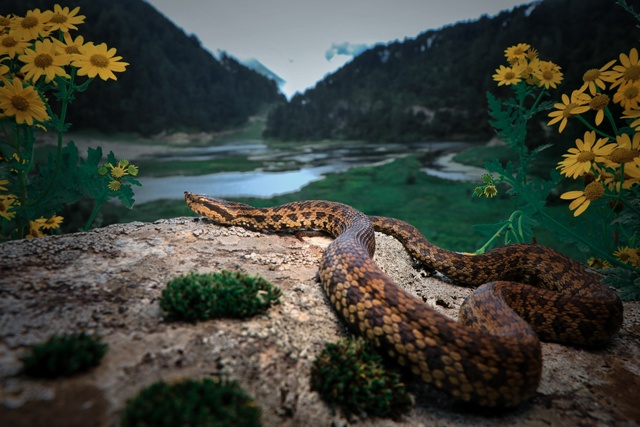Culture & Lifestyle
Charmed: the Pokhara man rescuing snakes from humans
Rohit Giri, a 21-year-old from Pokhara, is on a mission to make humans and snakes coexist peacefully.
Ankit Khadgi
A 16-foot-long King Cobra stares at Rohit Giri. Just as it starts moving away from him, Giri grabs its tail with the help of a hook. The snake in return turns towards him and tries to attack. The snake has been lingering in a family’s home for a while, and its residents are terrified. Giri is there to rescue the snake. After a few attempts, he finally succeeds and the residents of Kasari, Pokhara, thank him for saving them from what could have been a deadly situation.
This has become routine for the 21-year-old Giri from Davis Falls, Pokhara, because for the past four years he has been actively rescuing both venomous and nonvenomous snakes from Kaski and surrounding districts.
A second-year undergraduate student of biology at Prithvi Narayan Campus, Giri finds snakes fascinating. He feels drawn to them, despite the fact that most are repulsed by them. “Seeing people kill snakes has always made me sad. I felt that there was always a peaceful way of taking them out from human settlements, without hurting them,” says Giri. He wants to see humans and snakes coexisting together.
Recalling how his love for the ophidians started, Giri says that it was one particular book he read that made him fall in love with the creatures. “I was in grade 6 or 7 when I read a book which had colourful photos of snakes. Since then I have been drawn towards them,” says Giri.
His first rescue was four years ago, when he saved a green pit viper from his neighbourhood. Since then, he says, he has rescued more than 500 snakes, mostly from Pokhara and a few from surrounding areas.
Even with that much experience, not all of his rescues have been easy. A particularly tough rescue was three years ago, when he received a direct message on Instagram from a Syangja resident asking for help as a venomous cobra was sighted around the area. He says he initially went there out of curiosity, without an intention of rescuing the snake, but after seeing what the locals were going to do it, he felt compelled to rescue it.
“They were throwing stones at it and were even scaring it with blowtorches. I didn’t want the creature to die, so I decided to rescue it,” says Giri. “It was terrifying because the snake is venomous. I was scared it would bite me. But I wanted to save it.”
With the risks he takes, he has gained appreciation from locals who have come to understand what he is advocating for—not harming or killing snakes. It is natural for people to feel threatened when they find snakes in their premises and surroundings. The obvious reaction would be to kill them for fear of being bitten. Thanks to Giri, it’s now the other way around—whenever they find a creature slithering too close, they ring Giri, so he can rescue it.

“In March-April and June-July, when snakes are active, I usually rescue five to 10 snakes every day. People call me or contact me through social media to inform me of the presence of snakes. I, along with my brother, then perform the rescue” says Giri.
The nature of his rescue operations usually depends on whether the serpents are poisonous or not. If they are non-venomous, he usually uses a tong and puts them in a sack. But if he has to rescue a poisonous one, he uses a hook to put snakes into a large pipe-like apparatus, which he then covers with a sack. He then places that inside a box.
After rescuing the snakes, he frees them in forests far from humans, but he says he makes sure the area is a suitable habitat for the serpents. “The snakes can die or get killed by other creatures if they are left in a strange area. That’s why I leave them in open areas and forests close to where they were rescued from,” says Giri.
To keep himself updated about snakes, he reads whatever resources he can find in the form of books, articles or videos, both online and offline, he says.
Along with rescuing snakes, he also has a keen interest in photography. The snakes he rescues also becomes subject of his art, and his social media accounts are filled with pictures of them.
To follow his passion of photography and snakes, he has been using his Instagram profile as his portfolio, where he shares pictures of serpents to raise awareness among his followers, about various species and safety measures one should take if they find a snake in their home.
For his work, Giri has been offered money. But according to him, receiving money is against what he is advocating for—peaceful cohabitation between snakes and humans.
“If I start charging for rescues, people won’t invite me. They could resort to killing the creatures again, rather than paying money for someone to remove them,” he says. “I want people to have a mindset where they don’t kill snakes for their own safety, but that can only happen if I voluntarily rescue the snakes and earn their confidence. I can also advocate for snake preservation”.
He says he plans to go abroad to study herpetology, the study of amphibians and reptiles, once he graduates. “I want to research snakes found in Nepal. They haven’t been studied well. I want to travel all over and research them, as well as make people aware that human beings and snakes can peacefully coexist,” says Giri.




 17.12°C Kathmandu
17.12°C Kathmandu













%20(1).jpg&w=300&height=200)

